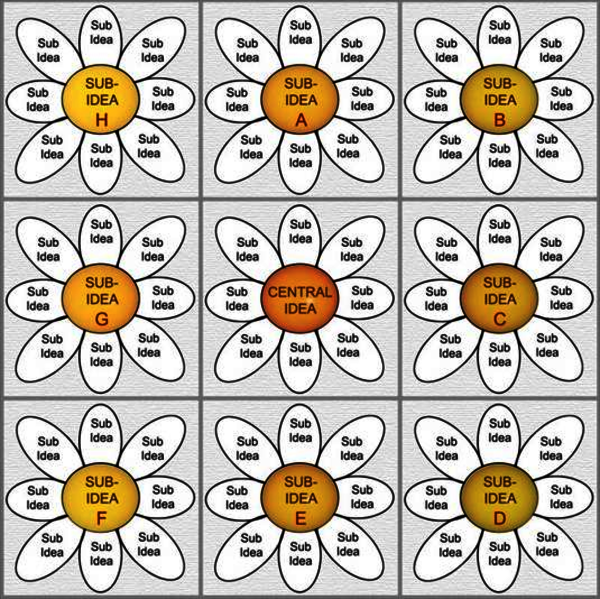Lotus Blossom Technique
The Lotus Blossom Technique is a creative method for idea generation and problem-solving. The group starts with a central idea, surrounded by eight empty circles or squares. Eight additional ideas (solutions or problems) are then written inside these. The result is a structured collection of ideas that promotes both divergent and convergent thinking.
Organisation
-
Duration
Medium (about 30-60 minutes)
-
Complexity
Medium
-
Group size
2 to 30 persons
This activity is not suitable online.
Description Long
The Lotus Blossom Technique originated in Japan and was developed by Yasuo Matsumura. The method uses the image of a lotus flower: A central idea forms the "core," from which eight "petals" with sub-ideas emerge. Each of these petals, in turn, becomes the centre of a new lotus blossom, leading to a more in-depth analysis. The aim is to address the root cause of a problem, or to peel away the petals of the lotus flower.
The process begins by defining a central theme and writing it in the centre of a 3×3 matrix. Eight initial subcategories are noted around the central idea. Each of these subcategories, in turn, becomes the central idea of a new lotus blossom and is further developed. The final result is a detailed overview with 64 sub-ideas, allowing for a comprehensive exploration of the topic.
Illustration

Preparation
- Create a template for the lotus blossoms (3×3 matrix).
- Define a clear problem statement or topic.
- If ideas were collected in a previous step, these can be added to the template using Post-its and further developed.
Online:
- Create a lotus flower template on the Miro board.
- Ensure that all participants have access to the Miro board.
- If ideas were collected in a previous step, these can be written on a virtual Post-it on the Miro board and assigned to the template.
Execution
- The central idea to be explored is written on a flip chart so that it is clearly visible to all participants.
- Around the main idea, eight key features or attributes of this idea are noted. These subtopics will later be further explored. The first eight attributes form the first lotus blossom, with each subtopic becoming the seed for a new lotus blossom.
- The subtopics become the central ideas for new lotus diagrams, and the process is repeated for each individual blossom.
- Once all the lotus diagrams are created, they can be used for analysis.
For online implementation, it is recommended to use a Miro board. The exchange can take place via Zoom or Teams.
Hints from experience
- For a manageable diagram, six to eight topics are ideal. If there are more than eight topics, new diagrams should be created.
- Questions such as the following should be asked: What are my goals? Where are the constants in my problem? What are the dimensions of my problem?
- Priorities can be set for ideas, solutions, and options using coloured pens or Post-its.
Tools list
- duct tape
- Sticky dots
- Paper, big, flipchart
- Sticky notes
- Writing utensils, pen, pencil
References
Higgins, J. M. (1996). Innovate or evaporate: creative techniques for strategists. Long Range Planning, 29(3), 370-380.
VanGundy, A. (2005). 101 activities for teaching creativity and problem solving. San Francisco: Pfeiffer, A Wiley Imprint.
Sloane, P. (2006). The leader's guide to lateral thinking skills. London: Kogan Page.
Jsalvis.com. Facilitation Technique Number 8: Lotus Blossom Technique. Retrieved 30 October 2015, from http://jsalvis.com/ReadingRoom/Business-and-Behavior/Facilitation/fac08a.htm
Lillicrap, D. (2011). The Lotus Blossom Technique. 5by5design.com. Retrieved 30 October 2015, from http://www.5by5design.com/blog/design-practice/lotus-blossom-technique/
Mahal, A. (2015). Facilitator's and Trainer's Toolkit: Engage and Energize Participants for Success in Meetings, Classes, and Workshops. Technics Publications.